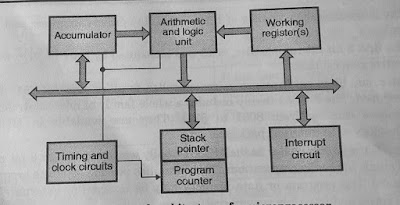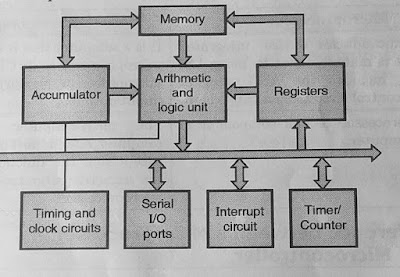Posted by
World Of Electrical Engineering
on
- Get link
- X
- Other Apps
The microprocessor is a central processing unit of a general purpose digital computer. They can address megabytes of memory and operate on 8, 16, or 32 bit data.
It consists of an ALU, accumulator, working registers, program counter, stack pointer, clock and interrupt circuits. Fig. shows general architecture of a microprocessor.
The microprocessor alone is not a complete digital computer. In order to make it a complete computers one should add memory devices (ROM, RAM, EEPROM, EPROM, PROM), memory decoders, I/O devices.
Due to varieties of memory and I/O devices, the hardware design of a microprocessor is arranged so that a very small or very large system can be configured around the CPU depending on the application of the user. For a small application the minimum size of memory and I/O (s) must be interfaced to the CPU. This increases the hardware. In turn the PCB size and cost of the system also increases.
 |
| Fig.1 General Architecture Of Microprocessor |
In order to avoid these drawbacks Microcontrollers were developed. The Microcontroller is an on-chip true computer. It is optimized for specific applications.
It consists all the features of a microprocessor as well as the features required to build a complete computer.
 |
| Fig.2 General Architecture Of Microcontroller |
The microcontroller has on-chip (built in) peripheral devices. They are ROM, RAM, Serial I/O, Parallel I/O, timer/counters, interrupts and clock. These on chip peripherals ake if possible to house single chip microcomputer system.
The microcontroller consists of RAM, ROM, I/O devices, counters and clock circuit etc.
The first 8 bit microcontroller, 8048 was introduced by Intel in 1976 with a view to control general tasks.
Later on, high performance microcontroller families like MCS51, MCS96 were developed. The MCS51 family includes a whole family of microcontrollers that have numbers ranging from 8031 to 8751. They are available in MOS or CMOS technology with different packages.
I read your blog now share great information here.
ReplyDeleteReverse engineering mcu